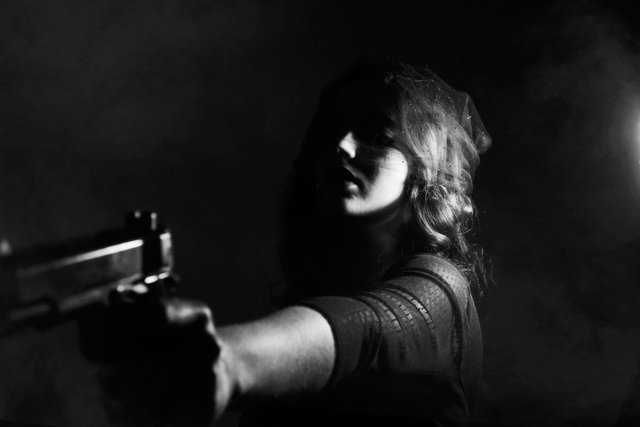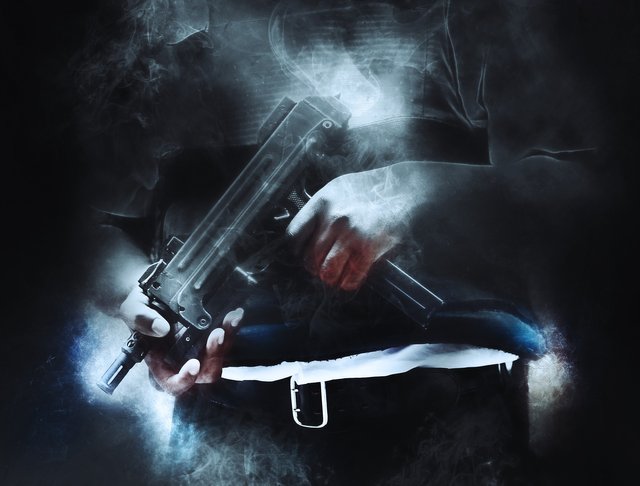How to Write Different Kinds of Violence
I don't read a lot of fiction these days. My tastes run towards action-packed thrillers, and as I discussed elsewhere, many writers have no idea how to write authentic action scenes. Outside the thriller genre, I can only name a small handful of writers who can instill in action sequences the ring of truth.
In a certain cyberpunk/space opera novel, the protagonist, a former Special Operations type turned private detective, encounters a thug on the streets. The thug woofs a challenge. The protagonist says, "Back off!" To underscore his point, he unleashes a series of strikes at the air, showing how he can kill the thug with his bare hands.
I can't tell you how that encounter ends, because that was the point I closed the book -- permanently.
Contrast this to Chapter 3 of Barry Eisler's The Detachment. Here, protagonist John Rain discovers he is being tailed. Rain uses stealth and surprise to turn the tables, eliminating the threats.
That encounter had the ring of truth. But pay attention also to the flashback in the middle of the chapter, in which Rain describes how he dealt with a bully. Between the ambush and the flashback, Eisler elucidates the principles of violence authors should aspire to capture in their own work.
Types of Violence
Violence is an instrument to achieve a goal. From this perspective, there are two kinds of violence: social violence and asocial violence. The former is for status and image, the latter is for resources.
The cyberpunk example is classic social violence. By dancing his hands in the air protagonist hopes to impress the thug and establish dominance. By contrast, John Rain employed asocial violence to defend himself: the resource in question is Rain's life.
Asocial and social violence have vastly different stakes and different goals. The resulting manifestation would naturally be vastly different.
The Monkey Dance
Imagine a pair of monkeys sizing up each other. They puff their chests and spread their arms, making themselves look bigger. Waddling up to each other, they hoot and shriek and gesticulate. At some point, one of three things happen.
*One of them submits and leaves
*One of them attacks, leading to a scuffle
*A higher status monkey breaks up the encounter
Humans behave in remarkably similar ways, which is where Rory Miller coined the term Monkey Dance. In his book Meditations on Violence, Miller describes it as a ritual with predictable steps. In American culture, it goes like this.
- Make eye contact with a hard stare
- Issue a verbal challenge, i.e. "What are you looking at?"
- Close the distance to bad breath range, sometimes ending in a chest bump
- Poke or push to the chest
- Punch
Here we see a progression of violence. First someone initiates the challenge and establishes status. As he closes, he continues mouthing off to psychologically prepare himself and to provoke the other guy into joining the monkey dance. Once in range, the chest bump and push serve as stepping stones, acclimatising the challenger to laying hands on the other person -- and, if the challenger were skilled enough, to allow him to gauge the distance. When the blood is up and he is committed, he throws a punch, and the fight breaks out.
The point of a monkey dance is to achieve status, not usually to take a life. Monkey dances are not usually lethal by design. People committed to the dance do not usually strike from ambush, call for help, pull weapons midway, use deadly strikes or finish off the loser. Crippling injuries or deaths are usually accidental. If a target is down, the challenger usually won't stomp the target into paste. On the other hand, a challenger would gladly knock out a target with a punch...and the target may fall on a hard surface and break his neck. But more often than not, the loser usually gets to walk away.
The same dynamic applies even where weapons are involved. In honour duels, the point is not to kill the other party -- it's to prove both parties' bravery. Most duels, especially in the West, tended to be fought to first blood, not to the death. After scoring first blood, both sides can walk away with their honour satisfied: the winner has proven his skill at arms while the loser has shown that he is willing to risk life and limb. Note that this does not apply to blood feuds settled through duels, or to cultures where even the slightest insult must be answered with deadly force.
This concept, however, breaks down for the Group Monkey Dance. This is another dominance game, in which members of a group compete for status and prove their loyalty to the group by showing how vicious they can be to an outsider.
This is the gang recruit brutalising an innocent person to the cheers of his new crew. The knockout game, the happy slap, the king hit. At the far end, it is the Imperial Japanese soldier bayoneting a prisoner, a squad of Waffen-SS gang-raping a civilian, the concentration camp guards competing to kill the most number of Jews in the shortest time.
The Monkey Dance is a non-lethal ritual to puff up the challenger. The Group Monkey Dance reinforces group loyalty through atrocity. Predatory violence is something else altogether.
The Predator
Asocial violence is about attaining resources. The victim is seen as an obstacle, an enabler or the objective. Think of it as an armed guard protecting a bank vault, the manager who holds the key to the vault, or the CEO whose high-profile assassination will terrorise the people.
The attack is a premeditated act of violence that enables the aggressor to take what he wants with minimal risk to himself. It will not be a fight in which both sides have a chance to exchange blows. It is not a contest with rules and referees. If weapons are available, they will be used. If killing is required, so be it.
Versus ritualistic monkey dancing, predatory violence is remarkably simple. It boils down to this: get close and unleash hell.
There are two main ways to get close. The first is to use the terrain to conceal yourself and set up an ambush. The second is to charm the target until you are as close as you can, then strike.
Simple. Brutal. Effective.
Implications for Writers
To write violence effectively, you need to know four things.
- What do the parties involved want?
- What is their background with violence?
- What skills, resources, advantages and disadvantages do they possess?
- What does their environment allow them to do and prevent them from doing, and what are their culture's rules of violence?
Let's go back to the cyberpunk example. The protagonist wants to move on with his investigation and walk away alive, while the thug wants to inflate his ego. The protagonist is former military Spec Ops, the thug is a street fighter. The protagonist has the benefit of decades of training and combat experience, while the thug knows the terrain and is accustomed to dealing with innocents. They are on a wide, empty street, with no opportunities for cover or concealment, and Western monkey dancing rules are in effect.
With this in mind, when the encounter begins, the easiest thing to do is for the protagonist to hold up his hands, back up and say, "Sorry, bro. It's been a long day and I'm just spacing out. I'll be leaving now, okay?"
The protagonist is ex-military with extensive experience in undercover operations. If neutralising the thug won't help him achieve his goals, why would he do it? Better to keep a low profile and walk away.
But let's say the thug presses on anyway. He's itching for a fight, and his friends behind him are egging him on.
"Not so fast, bro," he says. "You're on our turf now. You gotta pay the tax."
The thug's friends fan out, getting ready to cut the protagonist off. Here, we see the beginnings of a Group Monkey Dance, coupled with the opportunity for asocial violence -- i.e. to get the protagonist's wallet. Social and asocial violence aren't necessarily mutually exclusive, and opportunities for one or the other may emerge as events unfold.
How do you handle the situation? Here's an example:
--
The detective halts, his hands still raised.
"Sorry, man, I didn't know this was your turf. But I don't have anything in my wallet, 'kay? If that's fine with you, I'm leaving, okay?"
The thug smirks and steps up.
"Can't pay the tax? Then we'll just take it in--"
The detective jabs the thug's eyes. The thug howls and rears back. The detective slams a V-hand strike into his exposed throat and drives his knee into his groin. The thug falls, his voice fading into a strange click-click-click. The detective lifts his foot and axe-kicks him in the head.
The other criminals are rooted to the spot. The detective coolly regards them.
"Your friend needs a hospital."
He walks away, leaving the bad guys to their fate.
--
In this case, the detective short-circuits social violence with asocial violence. He lures in the thug with deceptive dialogue, strikes when he is distracted, and escalates beyond the point where the thugs are mentally prepared for. This causes the thugs to freeze as they try to process the new circumstances. He gives the gangsters a face-saving exit and quickly leaves before they can recover.
Note that the tactics involved would be much different if the protagonist were a civilian with no martial background. Instead of luring the bad guy in, the best approach would be to turn and sprint to safety. It's an open street; there's nothing stopping him from escaping if he's fit enough.
Social violence is about status and image. Asocial violence is about quickly, efficiently and safely obtaining resources. To win, either refuse the fight by leaving the scene, or overwhelm the other guy before he can do the same unto you.
The first step to writing authentic action scenes is to know what kind of violence you're writing about, and how well your characters fare and fit in those situations. Interesting things happen when characters are forced to overcome overwhelming force, navigate different cultures, or when they bring different violence paradigms to play. A battle-hardened warrior may scorn the idea of duels to first blood, or his culture may not even recognise such things, so whenever he fights someone it is always a duel to the death. A tipsy civilian may quickly find himself out of his depth after insulting a group of off-duty Marines. And so on.
Further Reading
The above is drawn heavily from Miller's Meditations on Violence. However, it is only the tip of the proverbial iceberg. Violence is a massive subject that no one person can cover in a single post. For further reading, look up Marc MacYoung, Rory Miller, Lawrence A Kane, Kris Wilder, Ed Calderon (aka Edpoint) and Jin Roh (the blogger). In particular, I recommend No Nonsense Self Defense and the Conflict Communications Group. To see how violence paradigms are applied in fiction, I recommend Barry Eisler, Marcus Wynne and Loren Christensen.
Writing is about truth. Writing violence is about reflecting the truth of violence. If your fiction involves realistic violence, doing the research pays handsome dividends.




Wow, I really like the psychological and social study in parallel to other animals. "The Monkey Dance" was a great term I'll never forget from here on. Furthermore, I really liked how you brought about the fact that "The point of a monkey dance is to achieve status, not usually to take a life.", it was poignant and we couldn't see it coming. In itself a beautiful surprise. Thanks a bunch for your write up today and namaste :)
Thank you. I'm glad you learned something from it. I borrowed that term from Rory Miller's Meditations on Violence and his blog at (http://chirontraining.blogspot.sg/). If you're interested, feel free to explore them.
Thanks a bunch for the reply and suggestion, namaste :)
Fantastic article, I'll definitely have to bookmark it for future reference. I can remember thinking about these principles over a decade ago when, in close proximity, I read "American Gods" and also watched the movie, "Brotherhood of the Wolf."
The protagonist Shadow in "American Gods" at one point describes the difference between real and fake fights in prison. The latter are flashy and for show, the former are brutal and over in seconds.
"Brotherhood of the Wolf" introduced the Iroquois warrior Mani in a non lethal fight scene filled with amazingly choreographed and acrobatic martial arts. Thankfully when the real conflict of the story occurred, it was all quick debilitating and lethal, nothing fancy or pretty about it.
It just happened that reading a passage in "American Gods" jogged me into thinking more about the differing violence I was seeing in other stories. Your article gives a lot more articulation and reference for further research. Thanks!
You're welcome. I'm glad that this has helped you. Real-world violence, the kind meant to cripple and kill, isn't pretty at all. In the future I'll be expounding on this, but it looks like American Gods and Brotherhood of the Wolf got it right.